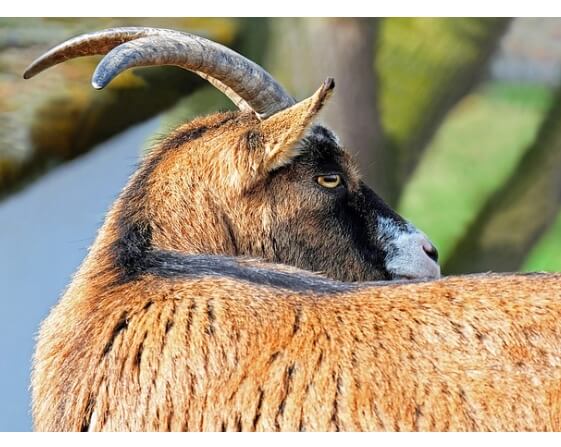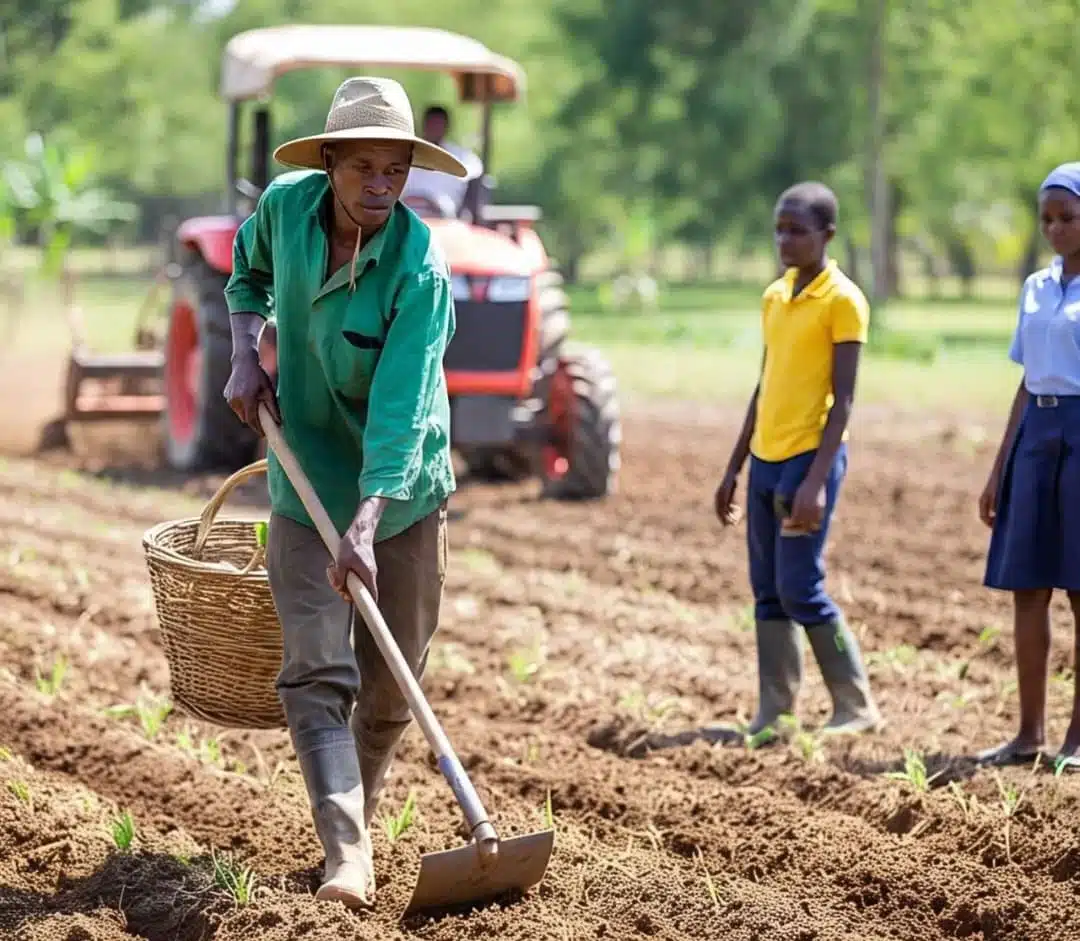Lesson Note – Agricultural Science – Primary 5 – Third Term – Week 2
Topic: Rearing of Farm Animals
Lesson Details
-
Subject: Agricultural Science
-
Class: Primary 5
-
Term: Third Term
-
Week: 2
-
Duration: 40 minutes
-
Age: 9 – 10 years
Learning Objectives
By the end of the lesson, pupils should be able to:
✅ Outline the kinds of animals that can be raised.
✅ Describe the importance of animal rearing.
✅ Raise animals of their choice.
Keywords
Rearing – Taking care of and raising animals.
Livestock – Farm animals kept for food or other products.
Poultry – Birds like chickens and turkeys raised for eggs or meat.
Domestication – Keeping and training animals for human use.
Set Induction (Introduction)
Teacher’s Action:
-
The teacher holds up pictures of different farm animals (cows, goats, chickens, and rabbits).
-
The teacher asks, “Who has seen any of these animals before?”
Rearing farm animals is a vital aspect of agriculture, especially in rural communities, where livestock play a key role in providing food, income, and other resources. Whether you’re considering starting your own small farm or just interested in the process, understanding how to properly care for and manage farm animals is essential. Let’s dive into the essentials of rearing farm animals, using personal experience and practical advice to make it easier to understand.
Why Rear Farm Animals?
Before jumping into the specific types of animals you can rear, it’s important to understand why people rear animals in the first place. As someone who has grown up in a community where farming was the backbone of the economy, I can tell you firsthand how essential it is. For many people, farm animals serve as:
Source of Food: Meat, milk, eggs, and other animal products provide vital nutrition.
Income Generation: Selling livestock or their products helps families support themselves.
Manure for Fertilizer: Animal waste can be used to enrich soil for crop farming.
Labor: Some farm animals, like oxen, are used for plowing fields.
Having lived in a farming community, I’ve seen how a few goats or chickens can help a family thrive. For others, raising cattle or pigs might be a bigger investment, but the rewards can be even greater.
Common Types of Farm Animals
There are a wide variety of animals that can be reared on farms, each with their own needs and benefits. Here are some of the most common ones:
1. Cattle (Cows)
Purpose: Dairy, meat, and labor.
Care Tips: Cattle require spacious barns and access to pasture for grazing. Regular feeding, clean water, and vaccinations are essential. When rearing cattle for milk, ensure proper milking hygiene to avoid contamination.
Personal Story: My uncle once told me about how a single cow transformed his family’s livelihood. After years of subsistence farming, he started milking cows, and the fresh milk quickly became a local favorite. It helped him fund his children’s education.
2. Goats
Purpose: Milk, meat, and fiber (like wool in some breeds).
Care Tips: Goats are hardy animals but need protection from extreme weather. They’re grazers, so plenty of pasture is necessary. Regular deworming is important, and you must watch out for diseases like mastitis in dairy goats.
Personal Tip: I remember my first experience with goats—how they’d escape through the smallest of gaps in the fence. They’re clever animals, and keeping them safe requires vigilance.
3. Poultry (Chickens, Ducks, Turkeys)
Purpose: Eggs, meat, and feathers.
Care Tips: Poultry needs a clean, well-ventilated coop to protect them from predators. For egg-laying hens, a balanced diet with plenty of calcium is essential. Regular cleaning of their living space will help prevent disease.
Personal Story: My mother once had a flock of chickens that kept us in eggs year-round. I’ll never forget the excitement of collecting eggs every morning—it was a simple yet fulfilling routine that made our breakfast table feel a little more special.
4. Pigs
Purpose: Meat production.
Care Tips: Pigs need space to move around but are usually kept in pens. Their diet should be rich in nutrients to support healthy growth. Pigs also require regular vaccinations, and keeping them in a clean environment reduces the risk of disease.
Personal Experience: I once visited a farm where pigs were raised for meat. I was surprised by how social they were, and how the farmer paid close attention to their dietary needs to ensure they grew quickly and healthily.
5. Sheep
Purpose: Wool, meat (mutton or lamb), and milk.
Care Tips: Sheep are grazers and require open pasture. They also need to be sheared annually, especially if you’re raising them for wool. Sheep are sensitive to extreme temperatures, so providing shelter from harsh weather is essential.
Tip: Shearing can be tricky if you’ve never done it before! It’s something I had to learn the hard way, but it’s rewarding once you get the hang of it.
Basic Steps in Rearing Farm Animals
Whether you’re starting with one animal or an entire farm, here’s a breakdown of the essential steps for successful rearing:
Build or Secure Appropriate Housing: Make sure each animal has a comfortable, safe place to live. For example, pigs need a muddy area to cool off in, while chickens need nesting boxes for laying eggs.
Provide Proper Nutrition: Each animal has specific dietary needs, so it’s important to understand what type of feed is best for them. For example, cattle need high-fiber feed, while chickens need protein-rich grains.
Regular Health Checks: Vaccinations, deworming, and monitoring for illnesses are critical to keeping your animals healthy and productive.
Breeding Management: If you plan to breed your animals, it’s important to understand their reproductive cycles and ensure that the animals are housed in a manner that promotes successful breeding.
Record Keeping: Keep track of breeding dates, health treatments, feed schedules, and any other relevant details. This will help you stay organized and keep your animals in optimal condition.
Challenges in Rearing Farm Animals
Rearing farm animals comes with its share of challenges, which I’ve learned over time. Some common issues include:
Health Concerns: Diseases like foot-and-mouth disease (in cattle) or avian influenza (in poultry) can have serious consequences for your farm.
Feeding Costs: Depending on the size of your farm, feed can take up a large portion of your budget.
Predators: Animals like coyotes, foxes, or even stray dogs can be a threat to livestock.
Personal Reflection
Growing up, I watched my family rear several animals. We didn’t have a large farm, but the chickens, goats, and cows we kept provided for us in ways I’ll never forget. The sense of responsibility I developed in taking care of the animals has shaped how I approach many things in life — from planning ahead to the importance of consistency in every task.
Conclusion
Rearing farm animals is a fulfilling, though sometimes demanding, part of agriculture. By understanding the needs of each species and committing to their care, you can enjoy the many rewards that come with raising healthy livestock. Whether for food production or as part of your overall farming operations, animals are at the heart of many successful farm businesses.
Remember, every farm is unique, and you’ll likely face challenges, but with the right knowledge, patience, and care, you can thrive in the world of animal husbandry.
Pupils’ Response (Funny & Realistic Classroom Interaction)
Ayo: “Aunty, my neighbor’s goat entered our kitchen and ate my mother’s soup!”
Mariam: “Chickens are very stubborn, they run away when you try to catch them!”
Emeka: “Our dog likes to steal meat from the pot!”
(The teacher laughs and responds positively, relating their experiences to the lesson.)
Entry Behaviour
-
Pupils have seen farm animals in their environment.
-
Some pupils may have pets or have visited a farm.
Learning Materials
Pictures or charts of farm animals
Video clips or real-life visits to a farm (if possible)
Models or drawings of farm animals
Building Background Knowledge (Funny Pupil Responses Included)
Teacher: “Do you know that some animals give us food, some help us on the farm, and some just love to disturb us?”
Bola: “Aunty, my uncle’s cow chased him one day because he forgot to feed it!”
Tolu: “I have a chicken, but it runs away every time I come near it!”
(The teacher uses these real-life funny moments to introduce the concept of rearing animals properly.)
Embedded Core Skills
✅ Critical thinking
✅ Communication
✅ Observation skills
Lesson Content
1. Types of Farm Animals
Farm animals can be grouped into different types:
A. Animals Reared for Meat, Milk, and Skin:
Cattle (Cows, Bulls) – Provide milk, meat, and leather.
Goats – Give meat and milk.
Sheep – Provide meat and wool.
B. Poultry Birds:
Chickens – Provide eggs and meat.
Ducks – Lay eggs and provide meat.
Turkeys – Large birds reared for meat.
C. Work Animals:
Horses & Donkeys – Used for carrying loads.
Oxen – Used for ploughing fields.
D. Other Animals:
Rabbits – Reared for meat.
Fish – Kept in ponds for food.
2. Importance of Rearing Animals
✔ Source of food – Meat, eggs, and milk come from farm animals.
✔ Source of income – Farmers sell animals and their products.
✔ Production of manure – Animal waste is used as fertilizer for crops.
✔ Employment opportunities – People work in farms to care for animals.
✔ Companionship and security – Dogs help guard homes.
3. How to Rear Animals
-
Provide food and water daily.
-
Keep animals in a clean shelter (pen, coop, or shed).
-
Vaccinate animals to prevent diseases.
-
Protect them from predators like snakes and wild dogs.
-
Ensure proper breeding for more healthy animals.
Evaluation (15 Fill-in-the-Blank Questions)
-
Animals reared on farms are called __________.
-
__________ provide us with eggs.
-
__________ is the process of taking care of animals.
-
Goats and cows produce __________.
-
Poultry birds include __________, __________, and __________.
-
__________ is used for ploughing the field.
-
Animal waste can be used as __________ for plants.
-
__________ is a small animal reared for meat.
-
We must give animals __________ and __________ daily.
-
__________ protects animals from diseases.
-
Farm animals provide __________ for human use.
-
The place where chickens are kept is called a __________.
-
Horses and donkeys are used for __________ loads.
-
Rabbits are reared for their __________.
-
A __________ is an example of an animal that provides leather.
Class Activity (FAQ for Discussion)
-
What are farm animals?
-
Why do people rear animals?
-
How do animals help in farming?
-
What do animals need to grow well?
-
Can we keep farm animals at home?
-
What should we do if an animal is sick?
-
What do chickens eat?
-
What is the best place to keep goats?
-
Why do farmers vaccinate animals?
-
What is manure, and how does it help crops?
-
Can we rear fish at home?
-
What is the difference between a cow and a goat?
-
Do animals need shelter? Why?
-
What farm animal do you like most?
-
What are some dangers that farm animals face?
Class Activity (FAQ for Discussion) – With Possible Pupil Responses
1️⃣ What are farm animals?
Farm animals are animals that people keep for food, work, or money.
Ayo: Like the goats that eat my grandma’s yam!
2️⃣ Why do people rear animals?
For food, money, and farm work.
Tolu: My uncle sells eggs, but I eat them for free!
3️⃣ How do animals help in farming?
They help plough the land, carry loads, and provide manure for crops.
Emeka: So cows are farmers too?
4️⃣ What do animals need to grow well?
Food, water, shelter, and medicine.
Mariam: Even animals don’t like being hungry like me!
5️⃣ Can we keep farm animals at home?
Yes, but we must take good care of them.
Bola: My mum said no goats at home because they eat everything!
6️⃣ What should we do if an animal is sick?
Take it to a vet doctor and give it medicine.
Chinedu: Like how I take medicine when I have a headache?
7️⃣ What do chickens eat?
Grains, corn, and sometimes insects.
Tunde: My grandma’s chicken even eats our rice!
8️⃣ What is the best place to keep goats?
A fenced area or a pen to stop them from running away.
Ada: Our neighbor’s goat once entered our house!
9️⃣ Why do farmers vaccinate animals?
To stop them from getting sick and dying.
Obinna: So cows also get injections like us?
What is manure, and how does it help crops?
Manure is animal waste used as fertilizer for plants.
Bisi: So poop helps plants grow? Ewww!
1️⃣1️⃣ Can we rear fish at home?
Yes, in a fish pond or a big tank.
Ibrahim: So I can start my own fish farm in my bathtub?
1️⃣2️⃣ What is the difference between a cow and a goat?
Cows are bigger, give more milk, and have longer horns.
Ngozi: Cows are more serious, but goats like to jump around!
1️⃣3️⃣ Do animals need shelter? Why?
Yes, to protect them from sun, rain, and wild animals.
Dayo: My dad built a house for his chickens; they sleep better than me!
1️⃣4️⃣ What farm animal do you like most?
I like chickens because they lay eggs.
Sola: I like cows because they give milk for my tea!
1️⃣5️⃣ What are some dangers that farm animals face?
Sickness, wild animals, bad weather, and thieves.
Kunle: That’s why my uncle ties his goat very well at night!
Presentation Steps
Step 1: Introduction (10 mins)
-
The teacher displays pictures of farm animals.
-
Pupils discuss the animals they know.
Step 2: Types of Farm Animals (10 mins)
-
The teacher explains different kinds of animals and their uses.
-
Pupils mention examples of animals they have seen.
Step 3: Importance of Rearing Animals (10 mins)
-
The teacher explains why animals are reared.
-
Pupils discuss how farm animals help humans.
Step 4: How to Rear Animals (10 mins)
-
The teacher describes how to care for animals.
-
Pupils discuss how they would care for their own animals.
VISUAL & INTERACTIVE ENHANCEMENT
1. Chart: Types of Farm Animals and Their Uses
| Animal Type | Example Animals | Uses |
|---|---|---|
| Poultry | Chickens, Ducks | Eggs, meat |
| Ruminants | Goats, Cows, Sheep | Milk, meat, leather, wool |
| Monogastrics | Pigs, Rabbits | Meat, manure |
| Work Animals | Donkeys, Oxen | Carrying loads, ploughing |
| Aquatic Animals | Fish (Catfish, Tilapia) | Food (protein), business income |
2. Visual Aids (Add to Digital Lesson or Print)
Images to Include:
-
A labelled image of chicken coop
-
A photo collage of Nigerian local goats, Zebu cows, backyard poultry
-
An illustrated cycle of animal rearing: Shelter → Feeding → Vaccination → Breeding
-
A cartoon-style diagram of “What animals give us” (milk, eggs, meat, wool, labor)
Teacher’s Activities
✅ Uses charts and pictures to explain different farm animals.
✅ Asks questions to assess understanding.
✅ Gives examples of animals and their uses.
Learners’ Activities
✅ Identify farm animals from pictures.
✅ Answer questions on why people rear animals.
✅ Discuss how they would care for an animal.
Assessment & Conclusion
Teacher asks pupils to:
-
Mention 5 farm animals.
-
Explain 3 reasons why we rear animals.
-
Describe how to take care of a chicken.
Teacher summarizes the lesson by:
-
Revisiting key points.
-
Encouraging pupils to observe farm animals at home.
Conclusion
The teacher reminds pupils that rearing animals is important for food, income, and farming. They should take proper care of animals and always keep them healthy and safe.
Reference Books & Materials
Agricultural Science for Primary Schools – Approved by the Ministry of Education
Charts, pictures, and real-life examples
From Farm to Plate: Teaching Kids About Agricultural Produce in Primary 1













